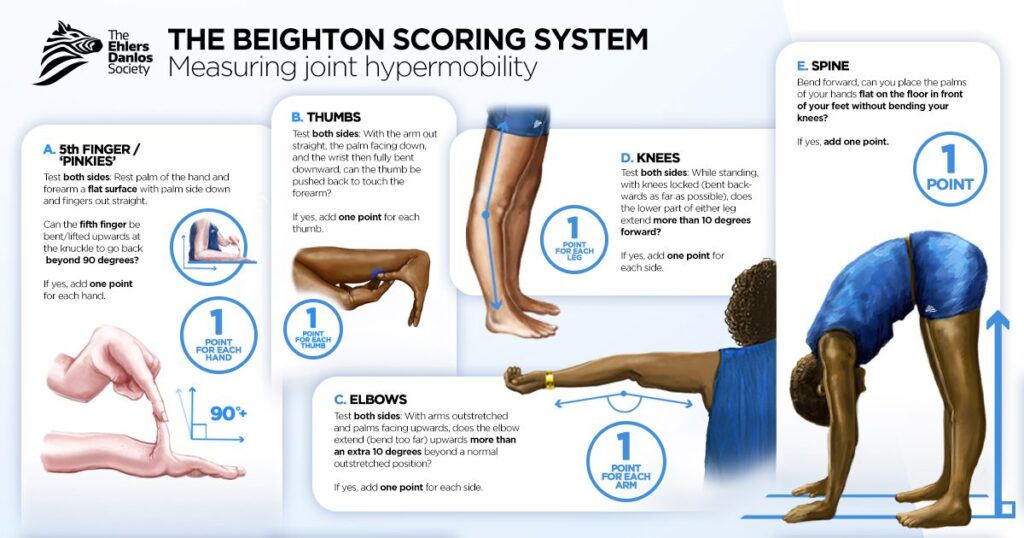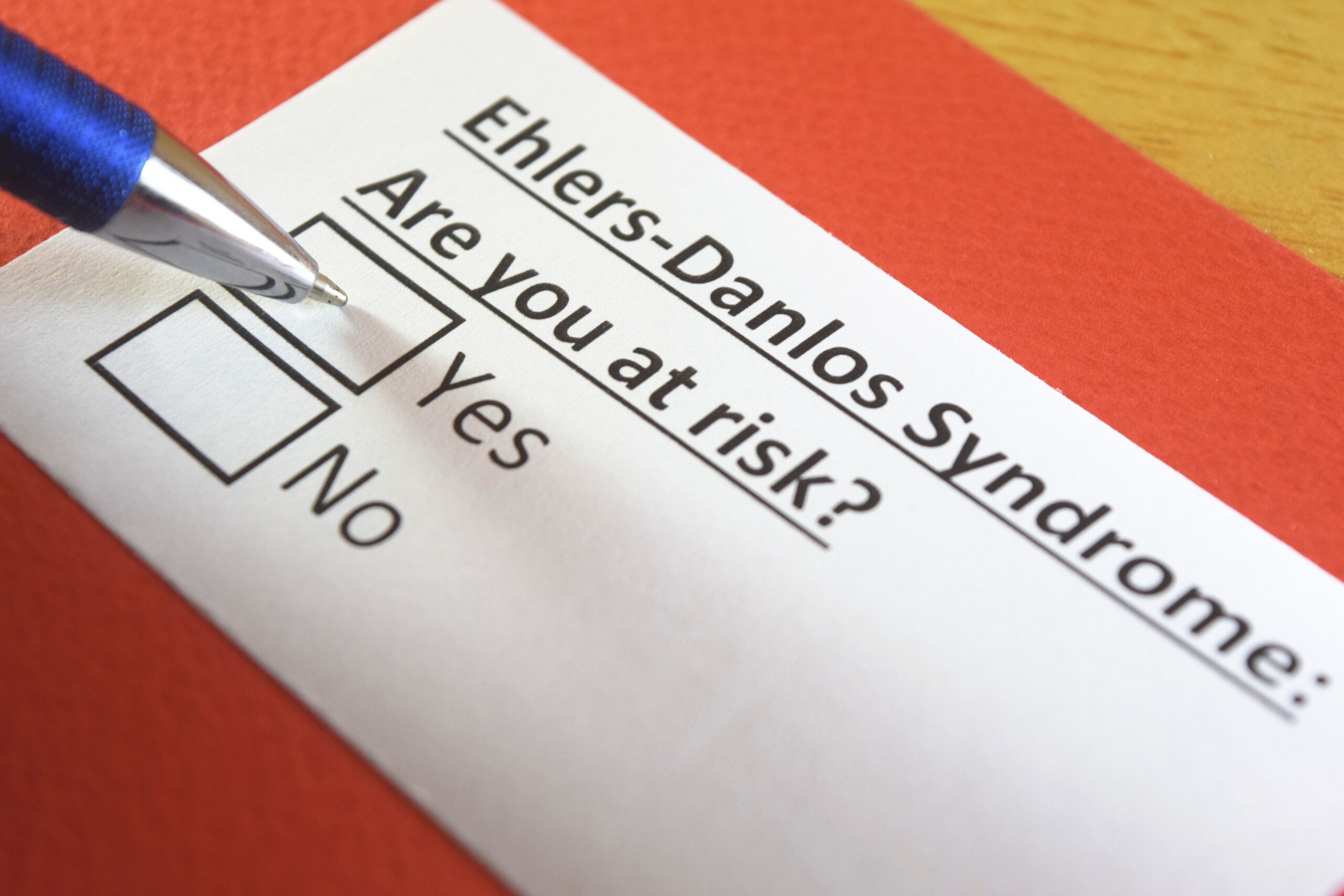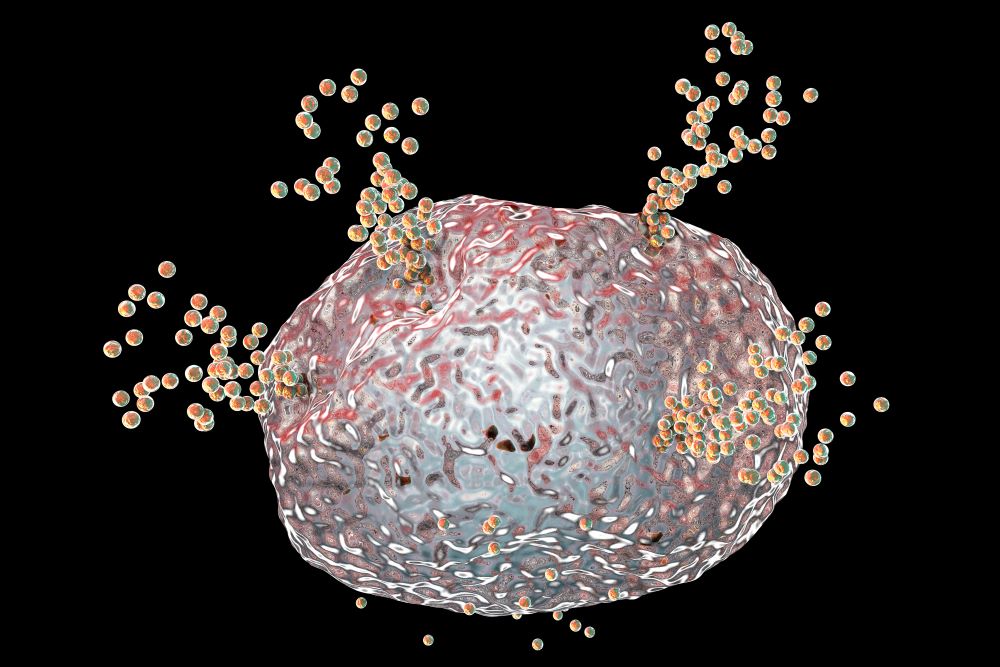Now live! RTHM Direct – simplified medication access for Long COVID, ME/CFS and related conditions. Check it out
Do your joints move in ways outside of the standard range of motion? Do you have a history of joint dislocations? Do you have stretchy or fragile skin? Do you suffer from chronic pain that just can’t be explained? If this sounds like you, it may be time to learn about Ehlers-Danlos Syndrome.
What Is Ehlers-Danlos Syndrome (EDS)?
Named after Dr. Edvard Lauritz Ehlers and Dr. Henri-Alexandre Danlos who identified the syndrome in the early 1900s, the earliest records of Ehlers-Danlos Syndrome date back to 400 BC and Hippocrates. Ehlers-Danlos Syndrome, known as EDS, refers to a group of 13 inherited connective tissue disorders that are characterized by abnormalities in collagen. This can affect everything from joints to skin, blood vessels, ligaments, and organs. The defects in the connective tissue are connected to mutations in specific genes and proteins that can be passed down through families, with the exception of hypermobile EDS. This type of EDS is not currently connected to a specific gene or protein; however, researchers still believe that an unidentified genetic mutation is behind the condition.
What Is Connective Tissue and Why Is It Important?
Connective tissue is found throughout the body and serves several important functions. It is a complex mixture of proteins and other molecules that provide structural support and mechanical strength. There are several types of connective tissue, including bone, cartilage, adipose tissue, blood, and lymphatic tissue. Each type of connective tissue has its own unique structure and function. Connective tissue plays a vital role in maintaining the structural integrity of the body, connecting and supporting tissues and organs, and transporting nutrients and waste products.
In those with one of the Ehlers-Danlos Syndromes, there is a mutation that affects collagen development and production, leading to weak or reduced collagen that can affect the ability to support muscles, organs, and tissue throughout the body.
Symptoms of EDS
 Each of the different types of EDS has unique symptoms and diagnostic criteria. However, some symptoms are seen across all forms of EDS, such as joint hypermobility, unique skin characteristics, and tissue fragility.
Each of the different types of EDS has unique symptoms and diagnostic criteria. However, some symptoms are seen across all forms of EDS, such as joint hypermobility, unique skin characteristics, and tissue fragility.
Joint hypermobility refers to the ability of joints to move beyond the traditional range of motion considered normal for a given joint. While this may not cause pain, it can lead to an increased risk of subluxations, dislocations, and sprains, as well as overall joint instability.
Skin in those with EDS is often very soft, thin, and fragile, and can stretch farther than the normal range. For example, if you pinch the skin on your forearm and can stretch it past 1.5cm, this is considered above the normal range and is a common marker seen with all forms of EDS. Those with EDS may also experience delayed wound healing and abnormal scarring as the collagen does not function as it should. These skin abnormalities, along with tissue fragility that can affect the skin, blood vessels, and organs, can make you vulnerable to bruising and poor wound healing, as well as increase your risk of potential organ damage.
Ehlers-Danlos Syndrome Symptoms Based on Unique Types
In addition to the common symptoms seen across all types of EDS, specific types of EDS cause unique symptoms that can include:
- Chronic pain
- Atrophic scarring
- Arterial fragility, increasing the risk of aneurysm
- Organ fragility
- Congenital hip dislocations
- Hearing loss
- Cornea complications
- Heart valve irregularities
- Foot deformities
- Shortened limbs
- Curvature of the spine, known as kyphoscoliosis
- Craniofacial abnormalities
- Gum disease and tooth loss
- Limb bowing
Different Types of EDS
 As of 2017, the different forms of EDS were broken down into 13 distinct types based on their symptoms and the absence or presence of the associated genes or proteins found through genetic testing.
As of 2017, the different forms of EDS were broken down into 13 distinct types based on their symptoms and the absence or presence of the associated genes or proteins found through genetic testing.
The 13 distinct forms of EDS include:
- Hypermobile EDS (hEDS) – Gene unknown
- Classical EDS (cEDS) – COL5A1, COL5A2, COL1A1
- Vascular EDS (vEDS) – COL3A1, COL1A1
- Arthrochalasia EDS (aEDS) – COL1A1, COL1A2
- Brittle Cornea Syndrome (BCS) – ZNF469, PRDM5
- Cardiac-Valvular EDS (cvEDS) – COL1A2
- Classical-Like EDS (clEDS) – TNXB
- Dermatosparaxis EDS (dEDS) – ADAMTS2
- Kyphoscoliotic EDS (kEDS) – PLOD1, FKBP14
- Musculocontractural EDS (mcEDS) – CHST14, DSE
- Myopathic EDS (mEDS) – COL12A1
- Periodontal EDS (pEDS) – C1R, C1S
- Spondylodysplastic EDS (spEDS) – B4GAL7, B3GALT6, SLC39A13
The Prevalence of EDS
Including all forms under the umbrella term of EDS, the estimates of incidence range between one in 2,500 to one in 5,000 diagnosed, meaning EDS is considered a rare condition. The most commonly diagnosed type of EDS is hEDS, with around one in 10,000 to one in 15,000 diagnosed whereas cEDS is diagnosed on an average of one in 20,000 to one in 40,000. Other types are so rare that only a small number of patients have ever been diagnosed. For example, the Genetic and Rare Diseases Information Center reports fewer than 1,000 patients diagnosed with dEDS in the U.S.
How is EDS Diagnosed?
There are over 200 conditions that fall under the umbrella term of hereditary connective tissue disorders, which can include the 13 types of Ehlers-Danlos Syndromes, as well as osteogenesis imperfecta and Marfan syndrome. When it comes to diagnosing a rare disease, such as a connective tissue disorder like Ehlers-Danlos, it is not uncommon to take several years to find medical professionals that are familiar with the conditions, can identify potential signs, and understand how to differentiate between these disorders.

Credit: Ehlers Danlos Society
A diagnostic journey for Ehlers-Danlos syndrome begins with a physical exam and thorough family history. A clinician evaluates you for hypermobility using the Beighton Score which involves simple joint movement and evaluation with a 9-point scale. The required diagnostic score in this flexibility test depends on your age and gender, with adult men and women up to age 50 requiring a score of more than five.
In addition to this flexibility scoring, a physical examination will also evaluate additional criteria, such as soft skin, skin hyperextensibility, dental crowding, and much more. For a full list of the diagnostic criteria for hypermobile Ehlers-Danlos Syndrome, CLICK HERE.
While hEDS can be diagnosed with a physical examination, if there is a family history of EDS or if your provider suspects one of the other forms of EDS, they may refer you for genetic testing with a geneticist to rule out or confirm other types of EDS.
Other tests your physician may order to look for signs of specific EDS types, as well as rule out other potential concerns or comorbid conditions, can include:
- X-rays
- CT (computerized tomography)
- MRI (Magnetic resonance imaging)
- Myelograms
- Electromyogram and nerve conduction studies
- Pulmonary function tests
- Angiography echocardiogram
Treatment Options for EDS
It’s important to note that there is no cure for EDS, so treatment focuses on symptom management and preventive measures to improve the quality of life for individuals with the condition. Treatment plans will also vary based on the type of Ehlers-Danlos you are diagnosed with.
EDS requires a multi-disciplinary group of healthcare professionals that can include geneticists, physical therapists, occupational therapists, cardiologists, dermatologists, pain specialists, and other providers to provide a comprehensive treatment plan tailored to each individual patient.
Below we look at some of the potential treatment approaches that you may experience as your providers work to create an individual treatment plan that addresses your unique symptoms and is based on your specific EDS type.
Medications
Medications may be added to your treatment plan and can include OTC pain relievers, NSAIDs, tricyclic antidepressants, beta-blockers, and muscle relaxants, as well as supplements such as calcium, magnesium, and vitamin D.
Physical Therapy
Targeted exercises and physical therapy can help improve muscle strength, joint stability, and coordination. A physical therapist familiar with EDS can guide you through appropriate exercises and techniques to help you protect your joints.
Joint Protection
Individuals with EDS are prone to joint dislocations and injuries. Strategies for joint protection, such as bracing or taping, may be recommended to provide stability and reduce the risk of joint damage.
Many with EDS and severe hypermobility have found success with the Body Braid. Visit HERE to learn more.
Skin Care
Fragile skin is a common feature of EDS. Good skincare practices, including gentle handling of the skin, avoiding trauma, and using moisturizers and sun protection, can help maintain skin integrity.
Wound Care
The fragile skin found in cEDS, for example, can lead to slow-healing wounds and an increased risk of infection. Appropriate wound care, including gentle cleansing, protection, and timely treatment of wounds, can help promote healing and minimize complications.
Genetic Counseling
As EDS is a genetic disorder, individuals with EDS or their family members may consider genetic counseling to understand the inheritance pattern, recurrence risks, and family planning options.
Blood Pressure Management
Maintaining optimal blood pressure is important for overall health, but even more important in those with vEDS. Individuals with vEDS should work closely with their healthcare team to control and manage blood pressure, as high blood pressure can increase the risk of arterial rupture. Medications such as beta-blockers and angiotensin receptor blockers may be prescribed.
Surgical Intervention
In some patients, such as those with vEDS, surgical interventions may be necessary to manage complications or prevent arterial rupture. These procedures may include arterial repair, grafting, or other vascular interventions. It’s important to have an experienced vascular surgeon who is familiar with vEDS perform these procedures.
Pain Management
Chronic pain is often associated with EDS. Pain medications, such as nonsteroidal anti-inflammatory drugs (NSAIDs), acetaminophen, or in some cases, prescribed analgesics, may be used to manage pain. It’s important to work closely with a healthcare provider to find the most effective and safe pain management strategy.
Psychological Support
Living with a chronic condition like EDS can impact mental health and well-being. Psychological support, such as counseling or support groups, can help individuals cope with challenges and maintain a positive outlook.
Education and Emergency Planning
Individuals with vEDS, for example, may receive education about the signs and symptoms of potential complications, such as arterial rupture, and have an emergency plan in place. Immediate medical attention should be sought if any concerning symptoms arise.
Common Comorbidities with EDS
Ehlers-Danlos syndrome (EDS) can be associated with various comorbidities. The specific comorbidities can vary among individuals, but some commonly diagnosed can include:
- Dysautonomia – Dysautonomia refers to the dysfunction of the autonomic nervous system. This system regulates involuntary bodily functions, such as heart rate. It can manifest as symptoms like orthostatic intolerance, postural orthostatic tachycardia syndrome (POTS), and gastrointestinal issues. Dysautonomia commonly co-occurs with EDS, particularly in the hypermobile subtype.
- Gastrointestinal (GI) disorders – EDS can be associated with various GI issues such as gastroesophageal reflux disease (GERD), irritable bowel syndrome (IBS), constipation, and gastroparesis. These conditions can cause abdominal pain, bloating, and altered bowel movements.
- Temporomandibular joint (TMJ) dysfunction – TMJ dysfunction, which affects the jaw joint, can be prevalent in individuals with EDS. It may lead to jaw pain, difficulty in opening or closing the mouth, and clicking or popping sounds during jaw movement.
- Chiari malformation – Chiari malformation is a condition where brain tissue extends into the spinal canal, often causing symptoms like headaches, neck pain, balance problems, and neurological issues.
- Tethered cord syndrome – Tethered cord syndrome is a condition in which the spinal cord is abnormally attached or “tethered” to surrounding tissue, typically at the lower end of the spinal column. It can be more common in individuals with certain connective tissue disorders, including Ehlers-Danlos syndrome
- Mitral valve prolapse (MVP) – MVP is a condition where the heart’s mitral valve doesn’t close properly. It can be more common in certain types of EDS and may require monitoring for potential complications, such as mitral valve regurgitation.
- Myalgic Encephalomyelitis/Chronic Fatigue Syndrome (ME/CFS) –ME/CFS is a debilitating chronic condition characterized by severe fatigue, post-exertional malaise, cognitive difficulties, and other symptoms.
- Mast Cell Activation Syndrome (MCAS) – Mast cells play a role in the regulation of connective tissue and can be found in higher numbers in tissues affected by EDS. In individuals with EDS, mast cells may be more prone to abnormal activation and release of inflammatory mediators, contributing to symptoms such as pain, inflammation, gastrointestinal issues, and allergic-like reactions.
As patients seek medical care for Long COVID or ME/CFS, some discover that they have underlying Ehlers-Danlos Syndrome. Here at RTHM, our clinicians are familiar with EDS and the treatments, support, and possible complications associated with the various forms of these genetic conditions. When you become a patient with RTHM, our clinicians work with you to create a thorough healthcare strategy that takes ALL your health concerns and comorbidities into consideration. No more bouncing from specialist to specialist, and missing possible connections between conditions. Our team coordinates your care in order to provide you with a comprehensive medical strategy that focuses on getting you better.

Get updates
Join our mailing list



